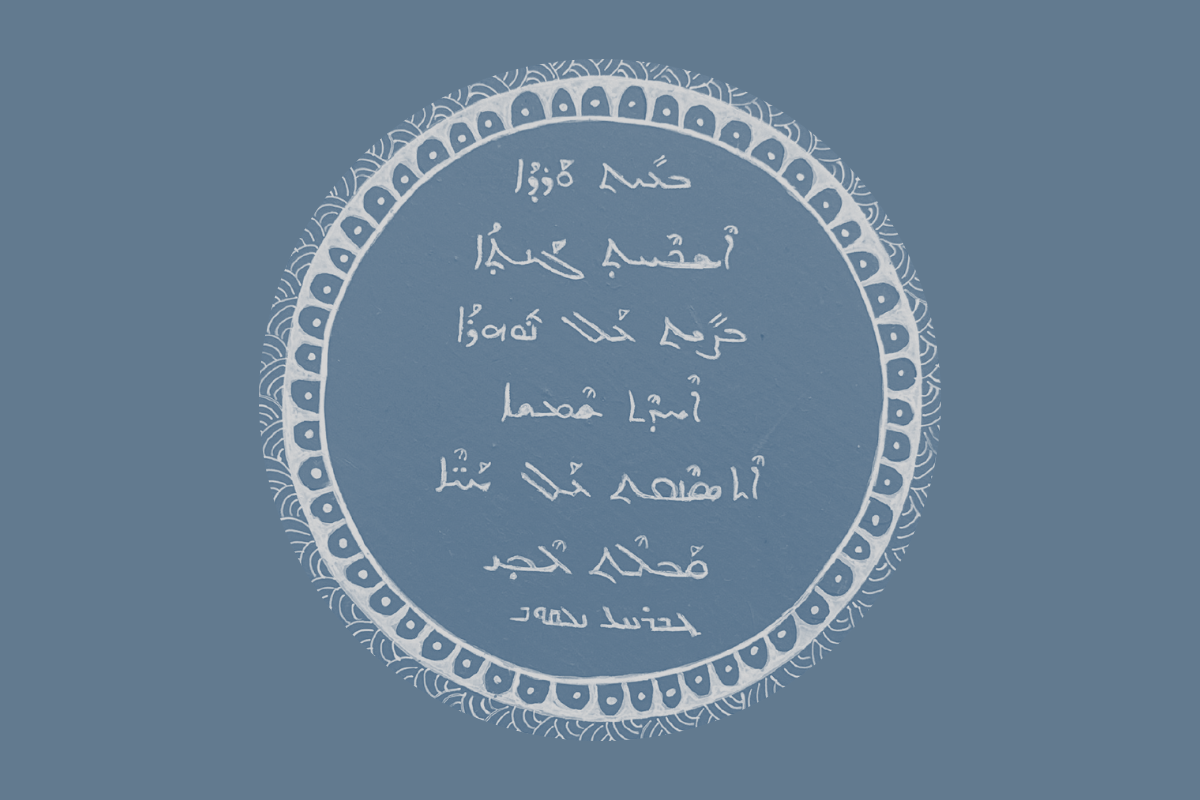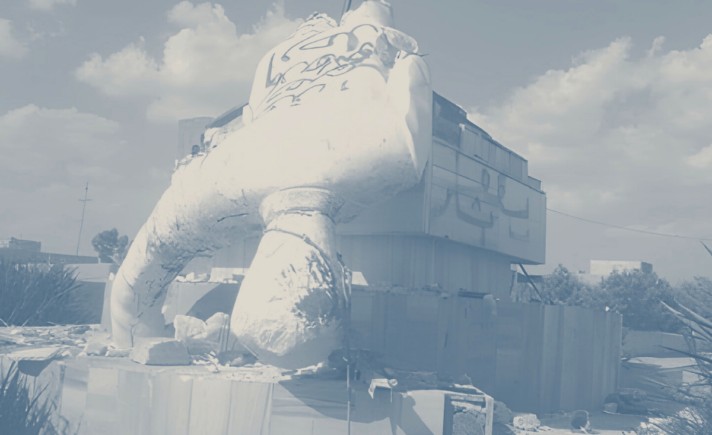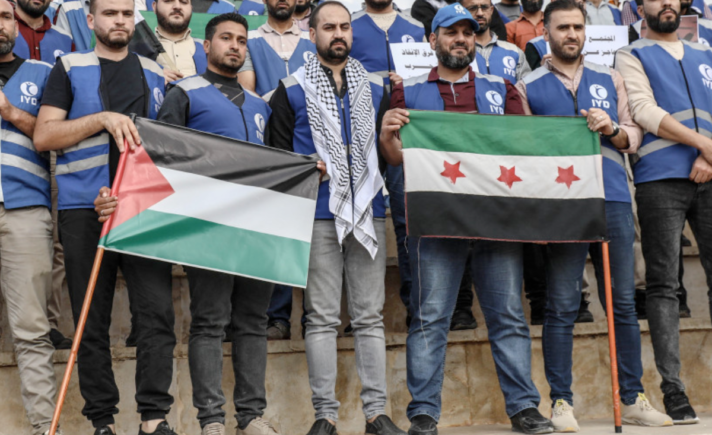Speaking Suryoyo in contemporary Syrian society can be a complex experience. While the language serves as a cherished link to our cultural and historical heritage, it can also create a sense of alienation, of not fully fitting into the broader Syrian societal context. This is particularly true in the case of activists from the Assyrian community working in Syrian civil society, and it is in this context that I have always felt some degree of patronisation for my Assyrian identity. My knowledge of Suryoyo was readily adopted as a useful diversity token for the movement, while my imperfect knowledge of Arabic – due to growing up in the diaspora – was seen as an annoyance. Searching for a place in Syrian civil society during the early years of the revolution, I rarely experienced appreciation or respect for speaking Suryoyo.
These linguistic and cultural differences have often made it challenging to seamlessly integrate, especially in activist settings where the dominant language was Arabic. Despite these challenges, speaking Suryoyo is an assertion of my identity and a powerful expression of my cultural pride and self-reception. It signifies the preservation of my unique heritage that contributes to the diverse mosaic of Syrian society, even if it comes with the need to navigate between tradition, a changing social landscape, and recent ethnic and religious tensions. The exposure of Suryoyo to a wider community, both in Syria and outside, leads to more understanding and acceptance of the Assyrian community within the tapestry of Syria. I believe that maintaining Suryoyo as an integral part of Syrian society will ensure not only the survival of the language but also the diversity of the Syrian people in their pursuit of a new Syrian identity outside of nationalist agendas. In this article I intend to address the main struggles relating to the survival of Suryoyo as part of Syria, as well as to encourage the key actors and decision-makers in Syrian civil society to take Suryoyo and the Assyrian people into consideration when considering the future of the country.
Suryoyo in Syria
Syria is a nation steeped in history and has been a melting pot of diverse cultures and ethnicities for centuries. Among the rich tapestry of communities that call Syria home, the Assyrians (also known as Syriacs or Arameans) have played a significant role in shaping the cultural landscape of the region. The importance of Suryoyo (ܣܘܪܝܝܐ), the native language of the Assyrian community in Syria (as well as in Iraq and Turkey), extends beyond its linguistic and religious dimensions: it serves as a cornerstone for preserving the country’s cultural heritage and nurturing a distinct identity.
The roots of Suryoyo can be traced back to the ancient Assyrians, an early civilisation which reached its height as an empire from 1400 to 600 BCE and covered territories of what is now Iraq, Syria, Lebanon and Palestine, also reaching Anatolia, Iran and Egypt. As one of the region’s first empires, it laid the foundation for much of the heritage of the SWANA region and the kingdoms that followed. The Assyrians used the Aramaic language for administrative purposes, and over time, this linguistic tradition evolved into Suryoyo, the Western dialect of Neo-Aramaic mostly spoken by Assyrians in South-Eastern Turkey and North-Eastern Syria (the corresponding Eastern dialect of Neo-Aramaic, known as Sureth, is mostly spoken by Assyrians in Iraq and some villages in Syria along the Khabur River). The historical significance of Suryoyo in Syria lies in its connection to the ancient civilisations that once flourished in the region. Indeed, the name ‘Syria’ itself originates from the ancient Greek name Syrioi, in reference to the ancient Assyrians (Aššūrāyu). As a living language with deep historical roots, Suryoyo serves as a bridge between the past and the present, connecting modern Suryoyo-speaking Syrians to their ancient forebears.
Suryoyo became more present in Syria following the 1915 Genocide (Sayfo) committed by Turkey against the Armenian, Assyrian and Pontic Greek minorities. My own ancestors were among the minorities expelled to Syria by the Ottomans, during the death marches which led to the creation of refugee settlements in Northern Syria, when cities such as Qamišlo (Qamishli), Dira Ze’urta (Deir ez-Zor) and Derik (Al-Malikiyah) becoming the new homes for many Assyrians displaced from Tur Abdin.
Suryoyo is not merely a means of communication; it is a vessel that carries the cultural heritage of the Assyrian people. The language (lišono) encapsulates centuries-old traditions, folklore and wisdom passed down through generations. Syria has a long history of ethnic and religious coexistence, and preserving Suryoyo is crucial to maintaining that cultural diversity. Efforts to safeguard and promote the language are integral to preserving the unique identity of the Assyrian community and ensuring that their rich cultural heritage continues to thrive.
The intertwined relationship between Suryoyo and Assyrian Christianity adds another layer of significance to the language in Syria. Various Christian denominations within the Assyrian community, such as the Syriac Orthodox Church (’ito Suryayto) and the Assyrian Church of the East, the Chaldean Catholic Church (as well as the Maronite Church in Lebanon), use Suryoyo (or its liturgical version, Classical Syriac) in their liturgical practices. The language has been the main medium for expressing religious devotion, performing ceremonies and reciting scripture. As a result, Suryoyo holds a central place in the spiritual identity of Assyrian Christians in Syria, providing a linguistic connection to their religious heritage.
Within the diverse ethnic tapestry of Syria, Suryoyo has served as a continuous thread, fostering heritage and identity for parts of the different communities – and in a world where globalisation and conflict often threaten indigenous languages, the preservation of Suryoyo should be seen as a powerful symbol of the region’s commitment to celebrating its rich cultural tapestry.
Art, Culture and Education
Despite its historical and cultural significance, Suryoyo has faced and still faces many challenges in the contemporary context of Syria. The Assyrian community, like many others, has endured displacement due to the ongoing conflict and persecution, leading to concerns about the preservation of their linguistic and cultural heritage in Syria. Additionally, the impact of modernisation and globalisation has led to the dilution of traditional languages in favour of the more widely spoken Arabic.
However, amidst these challenges, there are opportunities for revitalisation and preservation within the community, and particularly within the circles of young intellectual Assyrian activists. Educational initiatives aimed at teaching Suryoyo, both within Syria and in diaspora, are playing a crucial role in keeping the language, and with it the Assyrian identity, alive. Encouraging the use of Suryoyo in various aspects of public life, such as media, literature, and the arts, are contributing to its continued relevance and integration into contemporary Syrian society.
Suryoyo should not be confined to the realms of history and religious practices: it is a dynamic language that continues to evolve and adapt. Through cultural expression, including literature and art, Suryoyo has become a vibrant medium for the Assyrian community to convey their experiences, history, and identity. Literature in particular, be it poetry or historical documentation, used to be a powerful tool for both preserving traditional narratives and exploring contemporary themes. Unfortunately however, the rich oral tradition of storytelling within the Assyrian community rarely finds its voice in the written word, with many of the younger generations unable to read the Estrangelo and Serto scripts used to write Suryoyo, resulting in much of the oral tradition being lost or changed as it is passed down from generation to generation.
Music, on the other hand, has continued to connect the community to its roots. Traditional rhythms and melodies heard in folk music are passed down through generations, making their way into songs about the “old days” (yawme ’atiqe), the struggles for survival, the homeland (athro) and villages (qëryawothe) as well as old love stories. This use of music to preserve the stories of the past not only keeps the culture alive, but also allows for the re-discovery of Assyrian artistic expressions, making them relevant to younger generations in search of their indigenous identity.
Education must play a pivotal role in the preservation and revitalisation of Suryoyo. Efforts to teach the language in church schools (madëršothe) and community centres have been contributing to its transmission from one generation to the next. However, with the exodus of many Assyrians from Syria, as well as the violence and oppression by various armed opposition groups and Assad regime militias, the efforts to proactively teach the language have become sparse and difficult to implement. Suryoyo-centred education programs that incorporate Suryoyo alongside the official language(s) of the region could strike a balance between linguistic diversity and practical communication needs but often lack financial and institutional support.
Moreover, educational initiatives should not be limited to language instruction alone. They should encompass the broader cultural context, including history, traditions, and the significance of Suryoyo in religious practices and secular life. By fostering a holistic understanding of the language and its cultural roots, educational programs could instil a sense of pride and identity among Assyrian youth (’alayme), motivating them to actively participate in the preservation of their heritage.
Protecting Suryoyo requires active engagement and empowerment of the Assyrian community in a safe and stable environment. Initiatives that involve community members in the decision-making processes related to language preservation could be instrumental. Community-led projects, such as language revitalisation campaigns, cultural events, and exchange programs, are endeavouring to create spaces for the transmission of Suryoyo within a supportive and participatory framework.
A Language of Life
Promoting the use of Suryoyo in daily life is equally crucial. Language thrives when it is spoken, written, and shared in a daily context. Encouraging the use of Suryoyo in familial, social, and community settings reinforces its importance and helps create a linguistic environment where it can flourish. However, with the reality of the conflict, the demographic shifts and religious tensions in the region, it has become more difficult to move these efforts outside of the confines of private households and the church.
In the digital age, leveraging media and technology is becoming essential for the preservation and promotion of Suryoyo. Digital platforms, social media, and online resources are providing opportunities to reach a broader audience and connect Assyrians as well as other indigenous communities globally. Podcasts, online dictionaries, and interactive learning platforms such as phone apps are making Suryoyo more accessible than ever. The many initiatives dedicated to the use of the web to preserve Suryoyo, mostly with funding or bases in the diaspora, have been fostering a sense of pride and interest in the language. The use of digital tools to make Suryoyo accessible has even encouraged non-Assyrians to learn basic language skills and the written script, raising awareness of Suryoyo beyond the borders of Syria or even SWANA.
Similarly, the use of digital media in cultural expression, such as filmmaking, has been amplifying the visibility of Suryoyo, even if still to a limited extent. Documentaries, films, and online content that highlights the linguistic and cultural richness as well as history of the Assyrian community contribute to a broader appreciation of Suryoyo, both within Syria and on the global stage. The Assyrian community in the diaspora has been actively introducing satellite channels (such as SuryoyoSat and Assyria TV), Youtube channels for nursery songs (such as RinyoToons and BetKanu) and even podcasts to provide news, stories and live coverage of events in Suryoyo, allowing the community to consume entertainment in their own language. It has been through this digital revival that young diaspora Assyrians are able to rediscover their own language or even childhood songs, such as my personal favourite nursery song Tateh Tatteh, which I now enjoy even more in adulthood.
International support and visibility
Institutional support would be integral to the preservation of linguistic and cultural diversity, even if complex in the context of today’s Syria. Recognition of Suryoyo as a valuable component of Syria’s cultural heritage should lead to the implementation of policies that support its preservation. This recognition should extend to the allocation of resources for educational programs, cultural initiatives, and community-led projects aimed at preserving and promoting Suryoyo. Civil society organisations, research centres and community initiatives can also do more to include Suryoyo as a part of the diverse tapestry of Syria and proactively include both the Assyrian community and Suryoyo as a language in its work and outreach.
In addition to financial support, civil society and the various governance entities of North-Eastern Syria – be it the Assad regime or the Kurdish-dominated Autonomous Administration – should ideally play a role in creating an inclusive environment where linguistic diversity is celebrated, for example the inclusion of Suryoyo in official documents, public signage, and educational curricula. By actively acknowledging and promoting linguistic diversity, governance institutions could contribute to the creation of an environment where different languages and cultures coexist and survive, despite the many attempts to diminish identity outside of the Arab majority culture.
The preservation of Suryoyo is not only a local or national endeavour but a global one. Worldwide networks of Assyrian diaspora communities, cultural organisations, and advocacy groups have been collaborating to share resources, strategies, and experiences in language revitalisation. International organisations, cultural institutions and linguistic experts also play a role in supporting Suryoyo preservation efforts. Scholarly research, documentation, and the development of educational materials should be more supported to benefit from collaborative efforts that draw on a diverse range of expertise and perspectives.
Continuing the Tapestry
The importance of Suryoyo in Syria goes far beyond its linguistic utility. It is a dynamic and living aspect of Assyrian cultural identity, intimately connected to the historical roots, religious practices, and daily lives of the community as part of Syria. The preservation of Suryoyo is not just a matter of linguistic survival; it is a testament to the resilience of a people whose rich heritage has withstood the tests of time, including the 1915 Genocide, pan-Arabist attempts at erasure, and the challenges of modernity and cultural diffusion, as well as the recent conflict and displacement.
Having faced the challenges of displacement and persecution throughout history, and its culmination in the 1915 Genocide (Sayfo) in what is now modern-day Turkey, many Assyrians naturally empathise with the struggles of other oppressed groups in the region, notably the Palestinian people and the Armenians of Artsakh, both of whom continue to endure the consequences of occupation, displacement and linguistic erasure. The shared understanding of the importance of preserving cultural identity resonates deeply with many in the Assyrian diaspora. Solidarity between the Assyrian, Armenian and Palestinian communities represents a collective commitment to fostering a world where diverse cultures are respected and indigenous people’s rights are upheld, and it is a genuine hope that the same solidarity is given to the Assyrian people by other Syrians in their pursuit of survival.
Efforts to safeguard Suryoyo must be multifaceted, encompassing education, community engagement, cultural expression, technological innovation and international collaboration. As Syria navigates a changing demographic landscape, recognising and celebrating linguistic and cultural diversity should be an essential consideration in building a more inclusive society.
Ultimately, the continued vibrancy of Suryoyo in Syria depends on the collective efforts of the various Syrian, particularly Assyrian, communities, the support of governing institutions, and the support of regional and international solidarity movements. By valuing and preserving Suryoyo, Syria can ensure that the cultural tapestry woven by the Assyrian people remains a vibrant and integral part of the nation’s identity for generations to come.





